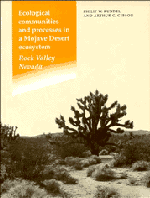Book contents
- Frontmatter
- Contents
- Preface
- Historical prologue on Rock Valley studies
- 1 Introduction to the Mojave Desert
- 2 Physical geography of Rock Valley
- 3 Adaptations of Mojave Desert plants
- 4 Desert perennials of southern Nevada
- 5 Mojave Desert annuals
- 6 Adaptations of Mojave Desert animals
- 7 Mammals
- 8 Reptiles
- 9 Birds
- 10 Arthropods
- 11 Soil organisms and seed reserves
- 12 Nitrogen cycling
- 13 Human impacts on Mojave Desert ecosystems
- References
- Species index
- Main index
Preface
Published online by Cambridge University Press: 19 October 2009
- Frontmatter
- Contents
- Preface
- Historical prologue on Rock Valley studies
- 1 Introduction to the Mojave Desert
- 2 Physical geography of Rock Valley
- 3 Adaptations of Mojave Desert plants
- 4 Desert perennials of southern Nevada
- 5 Mojave Desert annuals
- 6 Adaptations of Mojave Desert animals
- 7 Mammals
- 8 Reptiles
- 9 Birds
- 10 Arthropods
- 11 Soil organisms and seed reserves
- 12 Nitrogen cycling
- 13 Human impacts on Mojave Desert ecosystems
- References
- Species index
- Main index
Summary
The Mojave Desert is an expansive region of arid western North America, primarily in eastern California and southern Nevada. This is a winter rainfall desert, which, like the Negev in Israel, experiences drought conditions during the very hot summer months and occasional rain during the cooler months in late fall and winter. Researchers, especially those from academic institutions with close access to the Mojave Desert, have utilized key research sites to investigate how animals and plants cope with the rigors of desert life. Of the several Mojave Desert research sites, none has been as productive as a creosote bush desert scrub located in Rock Valley on the Nevada Test Site (NTS). The Nevada Test Site, operated by the United States Department of Energy (DOE), occupies 350 000 hectares of arid and semiarid terrains in central-southern Nevada. The location of this large reservation is particularly interesting because NTS straddles the geographic boundary between the Great Basin, which is classified as a cold desert, and the Mojave Desert.
As discussed briefly in our Historical Prologue, the history of ecological research at NTS dates back to 1951, when UCLA researchers were first permitted access, especially to its disturbed lands. Under research contracts with the former Atomic Energy Commission (AEC), NTS eventually was designated as a base for investigating patterns and processes of desert ecosystems, with special emphasis on the communities of the Mojave Desert, found in the southern portions of the reservation.
Research facilities at Rock Valley have existed since the early 1960s, when the AEC agreed to utilize this relatively pristine basin for long-term studies on the effects of low-level gamma radiation exposure to desert populations of plants and animals.
- Type
- Chapter
- Information
- Publisher: Cambridge University PressPrint publication year: 1996



